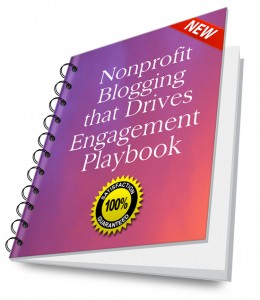
- What better way to talk about accomplishments your donors make possible than through stories that portray them as heroes?
Everyone loves a good story. Everyone.
Which is why storytelling should be at the heart of your nonprofit’s strategic communications. I know ‘storytelling’ is a meme du jour. But that’s no reason to ignore it. Just because everyone else is doing it doesn’t mean you shouldn’t! There’s a reason these phrases become buzzworthy. In this case, because you want to serve up content that’s relevant, attractive and accessible to your constituencies. Storytelling fits the bill better than anything else.
In fact, of all the content you can create, storytelling is your ultimate weapon and the most powerful means of communicating your message.
Let’s look at this a different way. From the perspective of another one of the memes du jour, ‘content marketing.’
I recently authored a post for Maximize Social Business about the reasons nonprofits need to adopt content marketing as the foundation of their strategy for communicating effectively with their audiences. You can read the full article, “Content Marketing and Social Media: What Nonprofits Must Know,” here.
In that article I offered up an 8-step plan to assure you create content that’s a gift to your constituents. Two of these steps have to do with storytelling. And since those steps generated some commentary, I’d like to offer some suggestions as to how to make storytelling happen at your nonprofit.
First, here are the steps I suggested:
1. Look for emotionally compelling stories that relate to content that is relevant to your audiences.
2. Look for stories that show folks how they can prevent an unhappy ending.
It seems that some folks thought this was easier said than done. One person wrote:
Storytelling, can’t agree more on that. Honestly, seldom can find someone who can really ‘do’ storytelling. Learn the trick of that and you are going to get some serious buzz; regardless what industry you are in.
Okay, so how do you ‘do’ storytelling?
Honestly, it’s not really a trick at all. You’ll find that if you practice it, storytelling comes very naturally. In fact, it’s the oldest form of human communication. Our brains are wired to tell stories.
Yet in an educational system prizing essays and term papers, and a work infrastructure valuing white papers, power points and reports, it’s easy to get out of practice.
We’ve become information junkies. Yet this isn’t satisfying us. Not at all. Robert Bruce, copywriter for Copyblogger, provocatively notes in How to Captivate Your Audience with Story:
The Information Age is coming to a close. It is crumbling around the ancient foundation of the human desperation for meaningful story, unadorned truth, and compelling drama that holds a mirror to life… Information is impotent to reach the hearts and minds of those who can use your idea, product, or service.
Never fear! Storytelling can be relearned, and there are lots of great resources out there to help you get started. Like anything else, it takes practice to get it right. That’s why I encourage folks to develop a culture of storytelling. As business and thought leader Jim Collins taught us:
We are known by the stories we can tell.
Make sharing stories a common practice within your organization. Infuse them into your culture. Here are some suggestions to ‘make it so’:
6 Story Collection Tips to Makes People Feel Good About Your Work
- Weekly TGIF Story Time.
Why not gather ’round every Friday afternoon for a glass of wine and some telling of stories that happened over the past week? Include not just marketing and development staff, but program staff, volunteer coordinators, business office, human resources, reception and everyone who interacts with the public. It’s important to collect stories relevant to all of your audiences. And it’s important to share with each other to reinforce that you’re really, truly doing great work. And you’re all in this together! If you feel great, you’re more likely to make your accomplishments sound great when you share them with others.
- Monthly Story Bank Brainstorm.
Hold a monthly staff meeting. Bring together folks from different departments who may represent perspectives of different constituencies. Guide folks through the telling of recent accomplishments through a storytelling format. Who was the main character? What was the challenge? How were obstacles overcome? Give lots of credit to your program staff for the great jobs they do. Be sure they know that they are the reason donors give! Then, go back to your office and write up any stories that come to peoples’ minds. Put them in a “story bank” (online or offline”) to save for future donor communications.
- Board Mission Moments.
Share a story at the beginning of every board meeting that reminds members why they joined the board. Tell a true tale of someone or something helped by your organization. Trust me, board members remember these stories much more than anything else that transpires at the meeting. And they will share them with friends.
- Board Story Share Time.
Open up the floor at the end of every board meeting for story time. Encourage members to share ‘feel good’ stories. They may be about an encounter with a prospective donor who shared good things s/he’d heard about your organization. Or they may be about an encounter with someone helped by your organization. They may even be a story about someone who needs help – thereby suggesting a new initiative for your organization and supporting your raison d’etre.
- Story Corner in Monthly E-Newsletter or Blog
Make a regular practice of sharing stories in your written communications. Consider “Why I Help; Why I Care” stories about donors and volunteers as well as “Thanks for Caring” stories from people your organization helped. Always put donors front and center as the hero of these stories.
- Staff Story Exchanges
Does your staff hold regular department meetings? What about making a practice of periodically inviting representative program staff to attend your meetings and tell a story? Ask if one of your staff can attend one of their meetings to tell one of your stories? It’s a great way to cross-pollinate, and it gets all of your organization’s staff thinking about what they do in terms of a story format.
Remember: Folks are more likely to understand, remember and share your content if it comes in a format that shows them the central challenge you seek to overcome — and how they can prevent tragedy. Your purpose in sharing content must be to persuade supporters that if your organization, and the donor, doesn’t help, something untenable will happen to your main character. The character may be a person, an animal, a place or a principle (e.g., overcoming injustice; saving the environment).
BOTTOM LINE: Practice Makes Perfect!
So put some of these strategies in place and start practicing. Regularly. Get to it!
If you have strategies you use to incorporate storytelling into your nonprofit culture, please share!
Want to learn more about how to share your progress year-round?
Check out the Nonprofit Blogging That Drives Engagement Playbook. Each guide takes you step-by-step through building a content delivery format that will resonate with your constituents and drive greater engagement. You’ll get actionable tips plus sample templates to get you started! Each volume comes from a different angle, so you can buy just the ones you need. As with all Clairification products, it comes with a money-back guarantee. To your success!
Image courtesy of freedigitalphotos.net







thanks so much for including me with your hidden golden eggs — the internet gems that can hopefully help so many charities.
Keep up the good work!